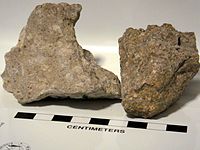
Photo from wikipedia
This study examines the role of North Atlantic storms degrading a Late Pleistocene rocky shoreline formed by basaltic rocks overlying hyaloclastite rocks on a small volcanic peninsula connected to Gran… Click to show full abstract
This study examines the role of North Atlantic storms degrading a Late Pleistocene rocky shoreline formed by basaltic rocks overlying hyaloclastite rocks on a small volcanic peninsula connected to Gran Canaria in the central region of the Canary Archipelago. A conglomerate dominated by large, ellipsoidal to angular boulders eroded from an adjacent basalt flow was canvassed at six stations distributed along 800 m of the modern shore at El Confital, on the outskirts of Las Palmas de Gran Canaria. A total of 166 individual basalt cobbles and boulders were systematically measured in three dimensions, providing the database for analyses of variations in clast shape and size. The goal of this study was to apply mathematical equations elaborated after Nott (2003) and subsequent refinements in order to estimate individual wave heights necessary to lift basalt blocks from the layered and joint-bound sea cliffs at El Confital. On average, wave heights in the order of 4.2 to 4.5 m are calculated as having impacted the Late Pleistocene rocky coastline at El Confital, although the largest boulders in excess of 2 m in diameter would have required larger waves for extraction. A review of the fossil marine biota associated with the boulder beds confirms a littoral to very shallow water setting correlated in time with Marine Isotope Stage 5e (Eemian Stage) approximately 125,000 years ago. The historical record of major storms in the regions of the Canary and Azorean islands indicates that events of hurricane strength were likely to have struck El Confital in earlier times. Due to its high scientific value, the outcrop area featured in this study is included in the Spanish Inventory of Geosites and must be properly protected and managed to ensure conservation against the impact of climate change foreseen in coming years.
Journal Title: Journal of Marine Science and Engineering
Year Published: 2021
Link to full text (if available)
Share on Social Media: Sign Up to like & get
recommendations!